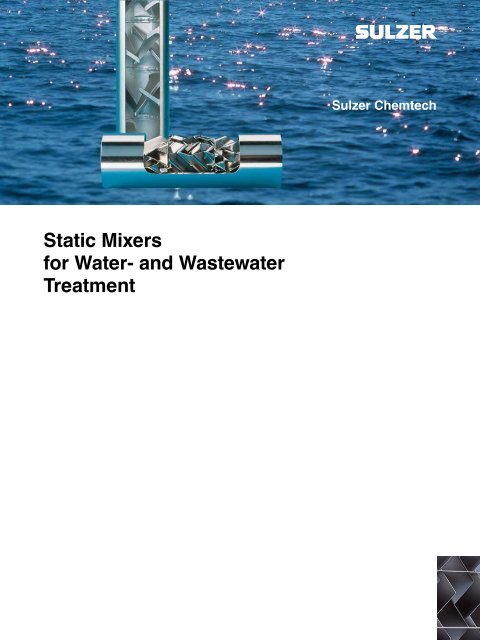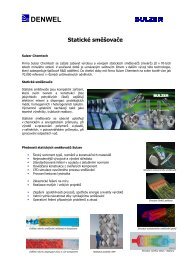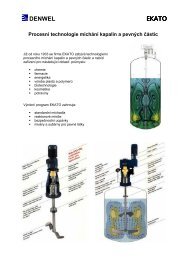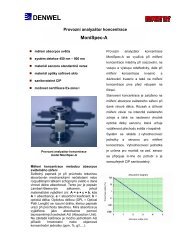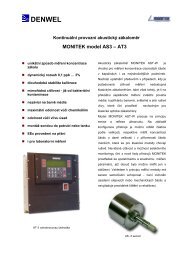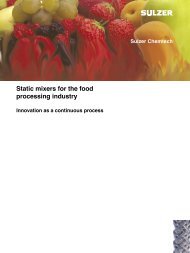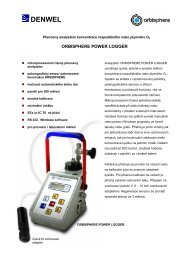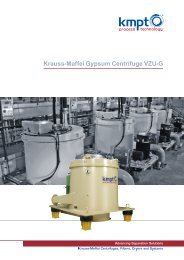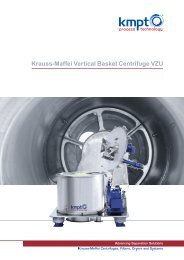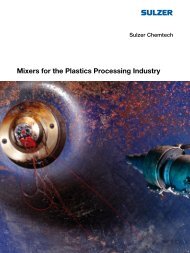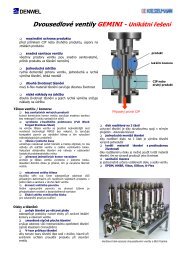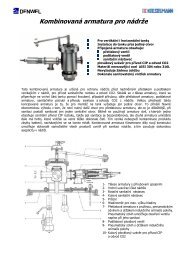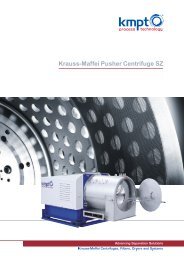Static Mixers for Water- and Wastewater Treatment
Static Mixers for Water- and Wastewater Treatment
Static Mixers for Water- and Wastewater Treatment
Create successful ePaper yourself
Turn your PDF publications into a flip-book with our unique Google optimized e-Paper software.
<strong>Static</strong> <strong>Mixers</strong><br />
<strong>for</strong> <strong>Water</strong>- <strong>and</strong> <strong>Wastewater</strong><br />
<strong>Treatment</strong><br />
Sulzer Chemtech
<strong>Static</strong> <strong>Mixers</strong> <strong>for</strong> <strong>Water</strong> <strong>and</strong> <strong>Wastewater</strong><br />
<strong>Treatment</strong><br />
In the field of water treatment, mixing <strong>and</strong> contacting are important unit<br />
operations having a fundamental influence on the per<strong>for</strong>mance of individual<br />
process stages or even on the results of the complete process itself.<br />
The ever increasing dem<strong>and</strong>s on water quality call <strong>for</strong> continuous improvement<br />
of the cleansing processes. This has lead to a marked increase in the<br />
general use of in-line static mixers <strong>for</strong> mixing <strong>and</strong> contacting operations in<br />
this sector.<br />
Design<br />
<strong>Static</strong> mixers <strong>for</strong> mixing <strong>and</strong> contacting<br />
operations are installed in-line in<br />
a process stream. The associated<br />
pipe or conduit can be round, square<br />
or rectangular in shape. The mixers<br />
are available in different designs<br />
<strong>and</strong> in a variety of materials, enabling<br />
optimum adaptation to meet individual<br />
process requirements.<br />
In the treatment of water, free of<br />
suspended solids, e. g. potable<br />
water, it is preferable to use the<br />
SMV mixer <strong>for</strong> both mixing <strong>and</strong> gas/<br />
liquid mass transfer procedures<br />
<br />
0681 2003-2<br />
Figure 1: Sulzer<br />
mixer SMV TM ,<br />
NPS 1400 mm,<br />
<strong>for</strong> mixing raw<br />
water with partially<br />
softened water<br />
<strong>for</strong> pH control.<br />
(figure 1). However, in mixing operations<br />
where the media involved contain<br />
solid particles, particularly fibres,<br />
plugging of the mixer can occur.<br />
In such circumstances, the use<br />
of the specially developed SMF mixer<br />
is recommended. The SMF mixing<br />
elements consist of inclined<br />
vanes which cross without touching<br />
each other <strong>and</strong> are fully open to the<br />
flow stream from all sides. This type<br />
of mixer is there<strong>for</strong>e not susceptible<br />
to plugging <strong>and</strong> is being used with<br />
success in the treatment of wastewater<br />
<strong>and</strong> sludge (figure 2).<br />
Function<br />
A static mixer consists basically of a<br />
sequence of stationary guide plates<br />
which result in the systematic, radial<br />
mixing of media flowing through<br />
the pipe. The flow path follows a geometrical<br />
pattern, precluding any<br />
r<strong>and</strong>om mixing. The mixing operation<br />
is there<strong>for</strong>e completed within a<br />
very short flow distance (figure 4).<br />
The <strong>for</strong>mation of fine gas bubbles<br />
in a water/gas mixture promotes intensive<br />
contact between the two<br />
phases (figure 3). The result is high<br />
mass transfer, <strong>for</strong> instance a high<br />
oxygen transfer rate or an excellent<br />
ozone utilization factor.<br />
In contrast to stirred tanks or empty<br />
pipe systems, static mixers ensure<br />
that the complete fluid stream<br />
is subjected to compulsory or en<strong>for</strong>ced<br />
mixing or contacting.<br />
The energy required <strong>for</strong> mixing or<br />
<strong>for</strong> mass transfer is taken from the<br />
main stream itself, which is manifested<br />
by an insignificantly higher<br />
pressure drop than in an empty pipe<br />
system. This value depends on the<br />
design of the mixer <strong>and</strong> on the relative<br />
operating conditions. It is generally<br />
in the range 0.02 - 3 m w. g.<br />
In comparison to dynamic agitator<br />
systems, the energy requirement of<br />
static mixers is smaller by at least an<br />
order of magnitude. In addition, the<br />
energy is evenly dissipated throughout<br />
the entire mixer volume.
Features<br />
• The face-to-face length of a mixer<br />
unit is short (1-5 pipe diameters)<br />
<strong>and</strong> consequently, the space<br />
requirement small. Retrofitting<br />
mostly presents no problem. The<br />
nominal diameter of the mixer is<br />
as a rule the same as that of the<br />
connected piping.<br />
0692 2735<br />
Figure 1: Sulzer polypropylene<br />
mixer SMF-PP of<br />
open design <strong>for</strong> operation<br />
in wastewater treatment<br />
without the danger<br />
of clogging.<br />
• The measured values are representative.<br />
This is a result of the<br />
continuous, balanced concentration<br />
across the entire cross-section<br />
of the flow.<br />
• The static mixer has no moving<br />
parts. There<strong>for</strong>e, there is practically<br />
no wear, <strong>and</strong> consequently<br />
very little maintenance is necessary.<br />
• The SMF mixer is not susceptible<br />
to clogging. Operation with media<br />
containing solid matter, such<br />
as slurries or suspensions with<br />
fibres or flakes, presents no problems.<br />
• Flexibility with regard to installation<br />
<strong>and</strong> material specification is<br />
high. <strong>Static</strong> mixers with round,<br />
square or rectangular crosssections<br />
are available. Installation<br />
in an open channel is also possible.<br />
The mixers can be supplied<br />
in stainless steel, carbon steel,<br />
PP, PVDF or in fibreglass rein<strong>for</strong>ced<br />
plastic.<br />
• The mixing effect remains constant<br />
even at changing operating<br />
conditions. Additives, <strong>for</strong> instance<br />
flocculating agents, are distributed<br />
rapidly <strong>and</strong> uni<strong>for</strong>mly. Excess<br />
dosing is no longer necessary<br />
<strong>and</strong> savings of up to 45% have<br />
been shown.<br />
• The complete process stream is<br />
subjected to en<strong>for</strong>ced mixing.<br />
Tanks can there<strong>for</strong>e be substantially<br />
reduced in volume or even<br />
be dispensed with altogether.<br />
0691 2726-4<br />
Figure 3: Blue colour concentrate<br />
is added to water in the pipe<br />
axis. A homogeneous mixture is<br />
achieved with a few SMV mixing<br />
elements.<br />
• The plant can be started up quickly.<br />
Continuous operation is a<br />
stable condition. The measurement<br />
data obtained are representative,<br />
thus enabling reliable control<br />
of the plant.<br />
• The <strong>for</strong>mation of fine bubbles results<br />
in a large interface between<br />
gas <strong>and</strong> liquid. The mass transfer<br />
rate is high.<br />
• Pressure drop <strong>and</strong> energy consumption<br />
are low. The pressure<br />
drop in mixing operations is<br />
< 0.02-2 m w. g. <strong>and</strong> in mass<br />
transfer operations
Examples of Practical<br />
Applications<br />
… over 4,500 references<br />
4588 4051<br />
The application potential in water, wastewater <strong>and</strong> sludge treatment<br />
extends over a wide range. Below, some examples taken directly from<br />
actual practice are explained.<br />
Diagram 1 shows a whole range of possible applications <strong>for</strong> static mixers in<br />
the chemical-physical treatment of water. Similar uses in treatment plants<br />
equipped with an additional biological stage are also possible.<br />
Figure 6: SMF-mixers <strong>for</strong> various mixing<br />
operations in wastewater <strong>and</strong> sludge treatment<br />
processes.<br />
pH control destabilization flocculation clarifier ozonization<br />
active carbon<br />
treatment sedimentation disinfection<br />
treated<br />
water<br />
acid<br />
base<br />
flocculent<br />
flocculent<br />
(polymer)<br />
flocculent<br />
(polymer)<br />
ozone<br />
active carbon<br />
suspension<br />
thickener<br />
sludge<br />
conditioning<br />
ozone<br />
chlorine<br />
chlorine dioxide<br />
fluorine<br />
mechanical<br />
sludge<br />
dewatering<br />
sludge cake<br />
Sulzer mixer<br />
0993 2711-1<br />
flocculent<br />
(polymer)<br />
treated<br />
wastewater<br />
Diagram 1: Examples of applications of static mixers in a chemical-physical water treatment plant.<br />
Flocculation (Diagram 2)<br />
In order to achieve optimum flocculation,<br />
alum (PAC), FeCI 3 , FeS0 4 or<br />
polyelectrolyte has to be distributed<br />
throughout the entire process stream<br />
as rapidly <strong>and</strong> as uni<strong>for</strong>mly as possible.<br />
These objectives are ideally<br />
achieved by employing new Sulzer<br />
CompaX mixers (figure 5). The en<strong>for</strong>ced-flow<br />
mixer ensures that the<br />
entire fluid stream is completely <strong>and</strong><br />
uni<strong>for</strong>mly mixed within fractions of seconds.<br />
Pockets of over-concentration<br />
are prevented, thereby economizing<br />
on flocculent. Savings of up to 45%<br />
have been achieved in practice.<br />
CompaX or SMF mixers are normally<br />
recommended <strong>for</strong> floccu-<br />
lation processes. The CompaX<br />
mixers have a total length of 0,5-1<br />
pipe diameter, the SMF mixers<br />
have a length of 2-5 pipe diameters<br />
(figures 2, 5 + 6). The mixer<br />
type is selected according to the<br />
specific process <strong>and</strong> customer requirements.<br />
For details on the pH value, refer to<br />
the description relating to diagram 4.<br />
1<br />
2 3<br />
0993 2712-1<br />
4<br />
6<br />
5<br />
1 Raw water<br />
2 Acid/base/lime slurry<br />
3 Flocculent<br />
4 Reaction/sediment tank<br />
5 Clear water<br />
6 Sludge slurry<br />
Diagram 2: Flocculation stage<br />
with pH control.
0603 2703-1<br />
In-line dilution of flocculents<br />
(Diagram 3)<br />
In order to achieve optimum activation<br />
of the flocculent, the prime solution<br />
has to be diluted with 10 to 100<br />
times its volume of water prior to<br />
addition to the sludge. As the prime<br />
solution (polymer) is in most cases<br />
of high viscosity, dilution in water is<br />
not spontaneous. It is there<strong>for</strong>e necessary<br />
to ensure thorough mixing,<br />
since the more uni<strong>for</strong>mly the polymer<br />
is distributed in the water, the<br />
greater its activity. Efficient mixing<br />
is secured by the use of a suitable<br />
static mixer. The result is a reduction<br />
in flocculent consumption <strong>and</strong><br />
consequently a saving in costs.<br />
SMV mixers made of PP or 316 Ti<br />
(= 1.4571) have proved successful<br />
in this application.<br />
1 Slurry<br />
2 Flocculent concentrate<br />
(polymer) or prime solution<br />
3 Dosing pump<br />
2<br />
4 <strong>Water</strong> <strong>for</strong> dilution<br />
5 <strong>Static</strong> thickener<br />
6 Decanter/centrifuge<br />
1<br />
3<br />
7 Dewatering filter<br />
8 Dewatered sludge<br />
9 Filtrate<br />
10 Thickened sludge<br />
11 Clear water<br />
4<br />
5<br />
10<br />
6<br />
9<br />
7<br />
9<br />
0605 2719-4<br />
Figure 5: CompaX TM NPS 1200 FRP <strong>for</strong> the<br />
admixing of flocculents in water treatment.<br />
11<br />
8<br />
8<br />
0993 2713-1<br />
Admixing of flocculent to sludge<br />
be<strong>for</strong>e dewatering<br />
(Diagram 3)<br />
The blending of flocculent into<br />
sludge prior to dewatering is an important<br />
process step having significant<br />
influence on the economics<br />
of the process as a whole. A complete,<br />
<strong>and</strong> at the same time careful<br />
mixing operation using a static<br />
SMF mixer can reduce flocculent<br />
consumption <strong>and</strong>/or increase the<br />
dry solids content of the dewatered<br />
sludge (figure 6). <strong>Static</strong> mixers are<br />
being used successfully in conjunction<br />
with all classic dewatering methods.<br />
Tasks relating to sludge dewatering<br />
are solely the domain of the SMF<br />
mixer. It normally is manufactured<br />
of stainless steel 316 Ti (= 1.4571).<br />
The pressure drop amounts to
0692 2745-2<br />
ph control or neutralization<br />
(Diagram 4)<br />
Neutralization reactions generally<br />
take place within a short time,<br />
but under the condition that mixing<br />
of the reaction components<br />
in the process stream is effected<br />
quickly. This duty is well suited <strong>for</strong><br />
the static mixer which enables the<br />
in-line neutralization reaction to be<br />
carried out directly in the pipe. Consequently,<br />
the volume of neutralization<br />
tanks can be greatly reduced or<br />
they can even be eliminated altogether.<br />
This space <strong>and</strong> energy saving<br />
solution is being used with increasing<br />
success in water treatment<br />
plants (figure 7). Not only is it possible<br />
to save on tanks but also a decrease<br />
in energy cost <strong>and</strong> the absence<br />
of maintenance work normally<br />
attached to dynamic agitators<br />
lead to an overall reduction in running<br />
costs.<br />
Diagram 4: pH control or neutralization.<br />
Figure 7: Mixing elements NPS 1000 mm <strong>and</strong> 1200 mm <strong>for</strong> admixing of<br />
flocculents <strong>and</strong> <strong>for</strong> adjustement of the pH value in a plant <strong>for</strong> treatment<br />
of drinking water. The mixing elements made of stainless steel will be<br />
installed in cement-walled pipes. The rings position the mixers to protect<br />
the pipe lining against damage.<br />
In order to promote the mixing of<br />
the neutralization media (acid, base,<br />
lime slurry), they are prediluted directly<br />
in-line in a supplementary<br />
small static mixer prior to being injected<br />
into the main stream (figure 8).<br />
Downstream of static mixers, the<br />
measurement of representative data<br />
is secured, an important factor <strong>for</strong><br />
the reliable functioning of a control<br />
system. The probes <strong>for</strong> controlling<br />
the neutralization agent dosing are<br />
as a rule placed 2-4 pipe diameters<br />
beyond the exit from the mixer.<br />
Neutralization is carried out using<br />
either SMV or SMF mixers of plastic<br />
or stainless steel. Their length<br />
is 2-5 pipe diameters <strong>and</strong> the pressure<br />
drop lies in the range of 0.02-<br />
2 m w. g.<br />
uni<strong>for</strong>mly throughout the entire water<br />
stream <strong>and</strong>, in the case of chlorines,<br />
in the shortest time possible.<br />
This operation is carried out with<br />
ease by SMV, SMI <strong>and</strong>/or CompaX<br />
mixers made of stainless steel. The<br />
pressure drop is about 0,02 – 1 m<br />
w. g.<br />
One of the main features of the<br />
CompaX mixers is short installation<br />
length, the simple dosing nozzle<br />
<strong>and</strong> the low pressure drop at the<br />
same efficient mixing per<strong>for</strong>mance.<br />
The CompaX mixers are nearly independent<br />
of mixing ratio <strong>and</strong> also<br />
have excellent turn down ratios.<br />
Diagram 5: Admixing of disinfectant.<br />
3<br />
Admixing of disinfectant<br />
(Diagram 5)<br />
Prior to entering the distribution<br />
network, the treated drinking water<br />
undergoes the addition of a small<br />
amount of disinfectant or fluorine.<br />
In order to obtain the desired effect,<br />
the disinfectants have to be blended<br />
1<br />
6 5 pH 4<br />
2<br />
1 Raw water<br />
2 Neutralization medium<br />
(acid/base/lime slurry)<br />
3 Neutralization feed tank<br />
4 pH probe<br />
5 Controller<br />
6 Metering valve<br />
7 Neutralized water<br />
7<br />
2<br />
1<br />
3<br />
4<br />
1 Main water stream<br />
2 Dilution water pump<br />
3 Disinfectant dosing pump<br />
4 To distribution network<br />
0993 2714-1<br />
0993 2715-1
0680 2046 / 0681 2038<br />
Figure 8: Sulzer mixer SMV in polypropylene<br />
(left) with feed pipe <strong>for</strong> additive injection<br />
(middle) <strong>and</strong> unit in PVDF <strong>for</strong> mixing of corrosive<br />
fluids (right).<br />
Deacidification with caustic soda<br />
solution (Diagram 6)<br />
If water is deacidified by the addition<br />
of caustic soda solution, there is generally<br />
danger of excessive precipitation<br />
of lime brought about by local<br />
overalkalinization. In time this can<br />
lead to blockages. Such an occurrence<br />
can be avoided if the concentrated<br />
lye (30 or 50%) is diluted<br />
to a 2% solution by the addition of<br />
softened water. This predilution<br />
takes place in a small SMI or CompaX<br />
mixer (made of stainless steel<br />
or PP) which can be directly integrated<br />
in the dosing system leading to<br />
the main mixer. The pressure drop<br />
of the mixer is about 0,05 – 2 m w.g.<br />
The empty pipe length in front of the<br />
main mixer dosing nozzle requires<br />
only 3 pipe diameters.<br />
2<br />
3<br />
1 4<br />
1 <strong>Water</strong> with free CO 2<br />
2 Softened dilution water<br />
3 Caustic soda solution (30 or 50%)<br />
4 Deacidified water<br />
Diagram 6: Deacidification with caustic<br />
soda.<br />
0993 2716-1<br />
The SMI or CompaX main mixer is<br />
made of stainless steel. The pressure<br />
drop amounts to 0,02 – 2 m<br />
w. g. The mixer type is selected to<br />
match specific requirements <strong>and</strong><br />
process data. Main criteria are the<br />
main water throughput, the turn<br />
down ratios, the mixing ratio <strong>and</strong><br />
the space limitations.<br />
Physical deacidification using<br />
air (single stage) (Diagram 7)<br />
Aggressive water can be physically<br />
deacidified by contacting with air.<br />
A stream of water is brought into<br />
intensive contact with as much air<br />
as possible at the lowest overpressure<br />
possible. As a rule, the water<br />
is contacted with three to four times<br />
the amount of air. The static mixer<br />
splits up the air into fine bubbles of<br />
1-2 mm in diameter. This results in a<br />
large interface of several thous<strong>and</strong>s<br />
m 2 /m 3 . An almost total equilibrium<br />
between the phases is established.<br />
Using suitable static mixers, a reduction<br />
of the free carbon dioxide<br />
by a factor of 2.5 is reached in one<br />
single stage. The mixer is manufactured<br />
of stainless steel <strong>and</strong> the pressure<br />
drop amounts to 1 -3 m w. g.<br />
Diagram 7: Physical deacidification using air<br />
(single stage).<br />
4<br />
3<br />
2<br />
1<br />
5<br />
Figure 9: SMI mixer with flanged additive<br />
dosing nozzle, made of stainless steel.<br />
0696 2704-1 0603 2705-4<br />
Figure 9a: CompaX mixers – available in<br />
different materials <strong>and</strong> sizes.<br />
1 <strong>Water</strong> with free CO 2<br />
2 Air<br />
3 Gas separator<br />
4 Exhaust<br />
5 Deacidified water<br />
0993 2717-1
0682 2024<br />
Oxygen enrichment of drinking<br />
water using by-pass aeration<br />
(Diagram 8)<br />
Drinking water entering the distribution<br />
network must have an oxygen<br />
content of at least 5-6 mg 0 2 /l. For<br />
this reason, treated water has often<br />
to be subsequently conditioned<br />
with pure oxygen. A small amount<br />
of oxygen has to be fully dissolved<br />
in the water. It is recommended that<br />
only a side-stream of water is highly<br />
enriched <strong>and</strong> then injected into<br />
the main stream. SMV mixers of<br />
stainless steel are used <strong>for</strong> this process.<br />
The mixer <strong>for</strong> the side-stream<br />
is slender <strong>and</strong> long, pressure drop<br />
< 10 m w. g.) <strong>and</strong> the mainstream<br />
mixer is thick <strong>and</strong> short, pressure<br />
drop 0.05-2 m w. g.).<br />
1<br />
4<br />
1 Drinking water<br />
2 Main supply pump<br />
3 Side-stream pump<br />
2<br />
3<br />
Figure 10: SMV mixer NPS 1200 mm <strong>for</strong> the admixing <strong>and</strong><br />
dissolving of CO 2 gas in drinking water produced in a<br />
sea-water desalination plant.<br />
4 Pure oxygen<br />
5 O 2 -enriched drinking water to<br />
distribution network<br />
Diagram 8: Oxygen enrichment of drinking water by means of side-stream aeration.<br />
0993 2718-1<br />
3<br />
5<br />
<br />
Direct aeration in a ground-water<br />
well (Diagram 9)<br />
For ground-water requiring no other<br />
treatment other than oxygen enrichment,<br />
the Sulzer enhanced aeration<br />
system has proved itself very successful.<br />
This system operates directly<br />
in the ground-water pumping<br />
shaft. Atmospheric air is brought into<br />
intensive contact with the water<br />
so that part of the oxygen content<br />
is dissolved in the ground-water.<br />
Such aerators have been operating<br />
efficiently in urban water treatment<br />
plants <strong>for</strong> many years. The equipment<br />
is distinctive <strong>for</strong> its low maintenance<br />
requirement, high degree<br />
of operational reliability <strong>and</strong> its efficiency.<br />
This aerator system can be<br />
installed both in new <strong>and</strong> in existing<br />
plants.<br />
The aerators are based on the SMV<br />
mixer <strong>and</strong> are adapted individually<br />
to suit the well site conditions. The<br />
length of the unit is 5-10 pipe diameters,<br />
the pressure drop 0.5-2 m<br />
w. g. <strong>and</strong> manufacture is of stainless<br />
steel.<br />
Diagram 9: Direct aeration in<br />
ground-water well.<br />
4 4<br />
2 1 2<br />
1 Ground-water well<br />
2 Inflow of ground water (low in O 2 content)<br />
3 Air<br />
4 Ground-water pumps<br />
5 O 2 -enriched water to<br />
distribution network<br />
0693 2719-1
3 4<br />
1<br />
2<br />
1 Inflow of water (low in O 2 content)<br />
2 Pump<br />
3 Air<br />
4 Reservoir<br />
5 O 2 -enriched water to distribution network<br />
0993 2720-1<br />
Diagram 10: Oxygen enrichment of drinking<br />
water in a reservoir.<br />
Oxygen enrichment in drinking<br />
water reservoirs (Diagram 10)<br />
Aeration of drinking water directly<br />
in a reservoir is carried out in the<br />
same manner as in groundwater<br />
well shafts (Diagram 9).<br />
5<br />
In-line, side-stream ozonization<br />
(Diagram 11)<br />
2<br />
3<br />
4<br />
As production of ozone is expensive,<br />
it is important to achieve the<br />
highest possible rate of its absorption.<br />
In practice, the SMV mixer has<br />
proved itself to be the most effective<br />
contacting device to meet this objective.<br />
It provides means of intensive<br />
contacting of water with ozone.<br />
When correctly dimensioned, a<br />
utilization degree of 90-99% of the<br />
physically possible value can be attained.<br />
The side-stream arrangement<br />
shown in the diagram has,<br />
above all, been successfully employed<br />
where the main stream is<br />
subject to considerable fluctuations<br />
in flow rate. The mixer in the sidestream<br />
is operated under hydraulically<br />
constant conditions so that<br />
even if the total flow rate is low, the<br />
ozone utilization rate still remains<br />
high. As in the case of oxygen enrichment<br />
of drinking water in a reservoir,<br />
the mixer in the main water<br />
stream can be relocated to the retention/reaction<br />
tank. By taking appropriate<br />
measures, it is also possible<br />
to increase the contact time<br />
between the ozone gas <strong>and</strong> the water<br />
in order to attain an even higher<br />
ozone utilisation. This is of particular<br />
advantage in cases where the<br />
water has a high ozone absorption<br />
rate.<br />
As the entire water stream is subjected<br />
to en<strong>for</strong>ced contact with<br />
ozone when flowing through the<br />
mixer, the subsequent residence<br />
tanks can be reduced in size. It is<br />
only necessary to dimension the<br />
tanks in relation to the actual reaction<br />
time without having to take the<br />
slow mixing into account.<br />
In this type of ozone introduction<br />
system, the side-stream mixer has<br />
a very short length with a pressure<br />
drop of 2-3 m w. g. It can there<strong>for</strong>e be<br />
fed directly with gas from the ozone<br />
generator without the necessity<br />
of an additional compressor. The<br />
pressure drop in the main mixer is<br />
< 2 m w. g., its length 3-6 pipe diameters.<br />
These mixers are manufactured<br />
from stainless steel.<br />
6<br />
1<br />
5<br />
7<br />
1 <strong>Water</strong> to be treated<br />
2 Air or oxygen<br />
3 Ozone generator<br />
4 Ozone gas mixture<br />
Diagram 11: In-line,<br />
side-stream ozonization<br />
5 Side-stream pump<br />
6 Retention/reaction tank<br />
7 Ozonized water<br />
0993 2721-1
0692 2718-1<br />
Iron <strong>and</strong> manganese removal<br />
stage (Diagram 12)<br />
The successful SMV mixer has<br />
been used as a basis <strong>for</strong> the development<br />
of the static aerator SMO 2<br />
(figure 11). This compact, field-proven<br />
aeration unit made of polypropylene<br />
is mainly used in the introduction<br />
of atmospheric oxygen into<br />
water during an iron <strong>and</strong> manganese<br />
removal process. With the help<br />
of this mixer, the oxygen necessary<br />
<strong>for</strong> oxidation is transferred efficiently<br />
into the water. Six different sizes<br />
of aerator from NPS 50-250 mm are<br />
available <strong>for</strong> treating water quantities<br />
ranging from 4-320 m 3 /h. The<br />
overall length of the mixer is 4-8 pipe<br />
diameters <strong>and</strong> the pressure drop<br />
is maximum 3 m w. g.<br />
When designing this stage, it is necessary<br />
to remember that the rate<br />
of oxidation depends largely on the<br />
pH value of the water. The optimum<br />
pH value is to be determined by the<br />
water engineer in charge. The value<br />
has no influence on the design<br />
of the aerator.<br />
Active carbon treatment stage<br />
(Diagram 13)<br />
In order that any substance present<br />
in the water can be fully adsorbed<br />
by the active carbon, it is of utmost<br />
importance <strong>for</strong> the efficacy of<br />
this treatment stage that the active<br />
carbon suspension is well <strong>and</strong> thoroughly<br />
mixed with the entire water<br />
stream. The suitable mixing principle<br />
of the static mixers ensures<br />
that this objective is fully achieved.<br />
This task is solved efficiently by the<br />
1<br />
1<br />
2<br />
2 3<br />
1 Raw water<br />
2 Acid/base <strong>for</strong> pH control<br />
3 Air<br />
4 SMO 2 operator<br />
5 Pressure reactor/gas separator<br />
SMF mixer made of stainless steel,<br />
with a length of 4-6 pipe diameters<br />
at a pressure drop of 0.05-1 m w. g.<br />
3 4<br />
6<br />
4 5<br />
Diagram 12: Stage <strong>for</strong> removal of iron <strong>and</strong> manganes.<br />
Diagram 13: Active carbon treatment stage.<br />
1 Pretreated water<br />
2 Active carbon suspension<br />
3 Filter<br />
4 <strong>Water</strong> <strong>for</strong> further treatment<br />
Figure 11: SMO 2 mixer in polypropylene <strong>for</strong> the aeration of water<br />
in the oxidation process <strong>for</strong> iron <strong>and</strong> manganese removal.<br />
0993 2723-1<br />
7 Exhaust<br />
8 Filter<br />
9 <strong>Water</strong> <strong>for</strong> further treatment<br />
7 8<br />
0993 2722-1<br />
10
0685 2019-1<br />
Operating range <strong>and</strong> installation<br />
position of static mixers<br />
<strong>Static</strong> mixers from Sulzer Chemtech<br />
cover a wide range of operating<br />
conditions <strong>and</strong> requirements.<br />
For the mixing of liquids, the static<br />
mixer is generally designed <strong>for</strong><br />
a flow velocity of 0.5-1.5 m/s. However,<br />
depending on the pipe diameter,<br />
the mixers can present perfect<br />
mixing results even at substantially<br />
lower flow rates. For most applications,<br />
the Sulzer mixer can be installed<br />
in any position whatsoever. If,<br />
however, there are large differences<br />
in the densities of the media to be<br />
mixed <strong>and</strong> if the minimum flow rate<br />
is extremely low, setup in a vertical<br />
position with upward flow is recommended.<br />
In processes involving gas/liquid<br />
contacting, the optimum bubble diameter<br />
is in the range of 1-2 mm<br />
<strong>and</strong> the necessary flow velocity<br />
between 0.5 <strong>and</strong> 2 m/s. To ensure<br />
that bubbles are distributed across<br />
the entire cross-section of the flow<br />
stream, the flow velocity should not<br />
fall below a minimum of 0.3 m/s. Below<br />
0.7 m/s, installation in a vertical<br />
position with upward flow is a st<strong>and</strong>ard.<br />
At higher rates, the choice of<br />
position <strong>and</strong> the flow direction is entirely<br />
optional.<br />
Available reprints <strong>and</strong> technical<br />
in<strong>for</strong>mation literature<br />
Further details can be obtained from<br />
reprints or from technical in<strong>for</strong>mation<br />
literature which deal closely with<br />
problems surrounding water <strong>and</strong><br />
wastewater treatment. On request,<br />
we can supply articles of special<br />
interest. The following publications<br />
are presently available:<br />
• <strong>Static</strong> <strong>Mixers</strong> Cut Chemical Costs<br />
• Sulzer SMF-PP Polypropylene<br />
<strong>Static</strong> <strong>Mixers</strong> <strong>for</strong> <strong>Water</strong> <strong>and</strong> <strong>Wastewater</strong><br />
<strong>Treatment</strong><br />
• Sulzer mixer SMI <strong>for</strong> turbulent<br />
flow<br />
• Sulzer CompaX – the space saving<br />
solution <strong>for</strong> your mixing operations<br />
• Effective Ozonation Using Sulzer<br />
<strong>Static</strong> <strong>Mixers</strong><br />
Our brochure «Mixing <strong>and</strong> Reaction<br />
Technology“ gives in<strong>for</strong>mation on<br />
the various applications of Sulzer<br />
mixers in different sectors of industry<br />
with over 60‘000 references.<br />
Scope of supply<br />
Sulzer mixers are available in a variety<br />
of materials. The adjacent table<br />
gives an overview of the current<br />
st<strong>and</strong>ard material specifications.<br />
<strong>Mixers</strong> manufactured from special<br />
materials such as hastelloy, titanium<br />
or monel are available on request.<br />
The largest SMV mixers manufactured<br />
to date <strong>for</strong> application in water<br />
treatment have a cross-section<br />
of 4m x 6.4 m or a diameter of 1.4 m,<br />
respectively.<br />
Material SMV TM SMF SMI CompaX TM<br />
Mixing elements Housing Mixing elements Housing<br />
Stainless Steel ≥ 1 / 2 ” ≥ 1 / 2 ” ≥ 1” ≥ 1” ≥ 1” 1 / 2 ” - 20”<br />
Carbon Steel ≥ 6” ≥ 6” ≥ 6” ≥ 6” ≥ 1”<br />
PP 1 / 2 ” - 14” ≥ 2” 2”-16” 1 / 2 ” - 20”<br />
PVDF 1 / 2 ” - 10” 1 / 2 ”-1 1 / 2<br />
PTFE 2” - 10”<br />
ETFE 1 / 2 ” - 1 1 / 2 ”<br />
CS/Liner 2”- 10” ≥6”<br />
GKF ≥ 10” ≥ 10” ≥ 24”<br />
11
0603 2532-2<br />
Headquarters<br />
Sulzer Chemtech AG<br />
P.O. Box 65<br />
CH-8404 Winterthur, Switzerl<strong>and</strong><br />
Telephone +41 (0)52 262 67 20<br />
Fax +41 (0)52 262 00 69<br />
E-mail chemtech@sulzer.com<br />
Internet www.sulzerchemtech.com<br />
North <strong>and</strong> South America<br />
Sulzer Chemtech USA, Inc.<br />
4019 S. Jackson Street<br />
US-Tulsa, OK 74107<br />
Telephone +1 (918) 445-6614<br />
Fax +1 (918) 445-6670<br />
Asia Pacific<br />
Sulzer Chemtech Pte. Ltd.<br />
Regional Headquarters<br />
25 International Business Park<br />
#03-28 German Centre<br />
SG-60 99 16 Singapore<br />
Telephone +65 6863 75 60<br />
Fax +65 6861 15 16<br />
Sulzer Chemtech Ltd, a member of the Sulzer Corporation, with headquarters<br />
in Winterthur, Switzerl<strong>and</strong>, is active in the field of process engineering<br />
<strong>and</strong> employs some 1500 persons worldwide.<br />
Sulzer Chemtech is represented in all important industrial countries <strong>and</strong><br />
sets st<strong>and</strong>ards in the field of mass transfer <strong>and</strong> static mixing with its advanced<br />
<strong>and</strong> economical solutions.<br />
The activity program comprises:<br />
• Process components such as trays, structured <strong>and</strong> r<strong>and</strong>om packings,<br />
internals <strong>for</strong> separation columns <strong>and</strong> reaction technology<br />
• Engineering services <strong>for</strong> separation <strong>and</strong> reaction technology such<br />
as optimizing energy consumption, plant optimization studies, preengineering<br />
<strong>for</strong> governmental approval, basic engineering<br />
• Separation <strong>and</strong> purification of organic chemicals by means of crystallization<br />
<strong>and</strong> membranes<br />
• Mixing <strong>and</strong> reaction technology with static mixers<br />
• Tower field services<br />
Distributed by:<br />
23.83.06.40-IV.06-50 - Printed in Switzerl<strong>and</strong>


